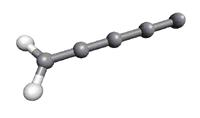|
The observed transition frequencies were taken from
(1) M. C. McCarthy, M. J. Travers, A. Kovacs, C. A. Gottlieb, and P. Thaddeus,
1997, Astrophys. J. Suppl. Ser. 113, 105.
With respect to the second entry from May 2002, higher-J data
from astronomical observations were added. These were published
by
(2) C. Cabezas, B. Tercero, M. Agúndez, N. Marcelino, J. R. Pardo,
P. de Vicente, and J. Cernicharo,
2021, Astron. Astrophys. 650, Art. No. L9.
An estimate of d1 does not affect the fit,
but may improve the reliability of higher-J data.
The calculations are sufficiently accurate for observations of
cold sources. The calculations were truncated at
Ka = 2 because no data are available for these
and higher Ka. Transition frequencies with
Ka = 2 or above 100 GHz should be viewed
with caution.
The calculated value for the dipole moment was taken from
(3) S. A. Maluendes and A. D. McLean,
1992, Chem. Phys. Lett. 200, 511.
At low temperatures, it may be necessary to discern between
ortho-l-C5H2 and
para-l-C5H2. The ortho states
are described by Ka odd, the para states
by Ka even. The nuclear spin-weights are 3 and 1
for ortho-l-C5H2 and
para-l-C5H2, respectively.
The JKaKc = 111
is the lowest ortho state. It is approximately 9.34
cm–1 above ground.
|
